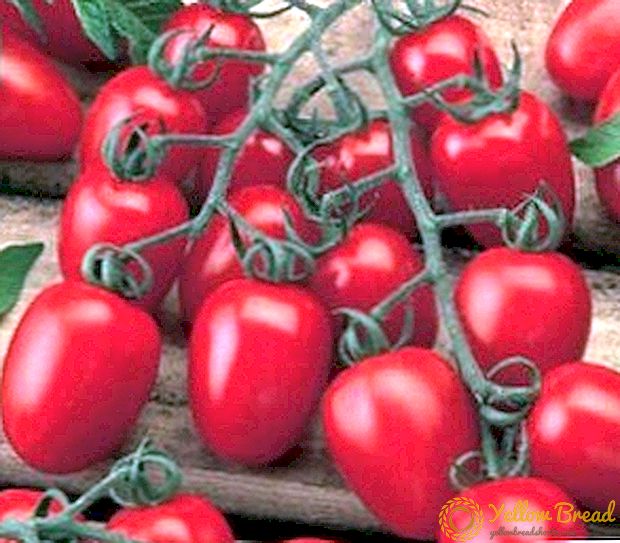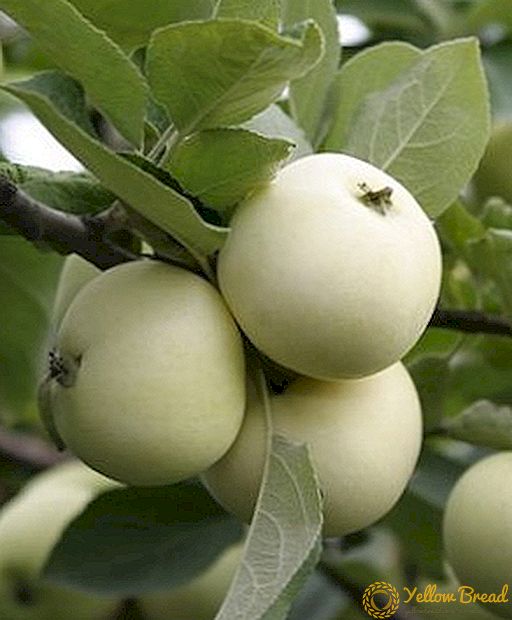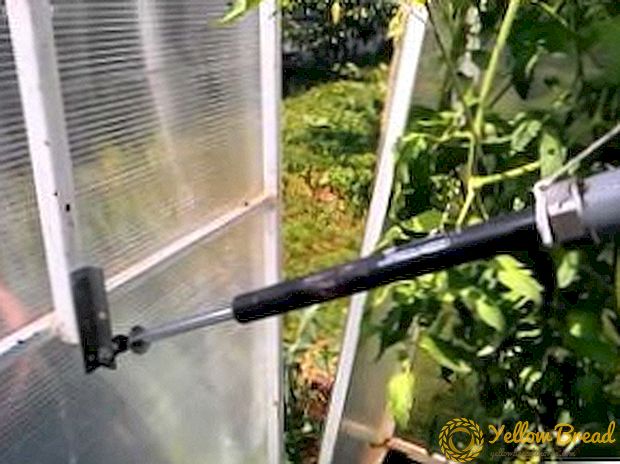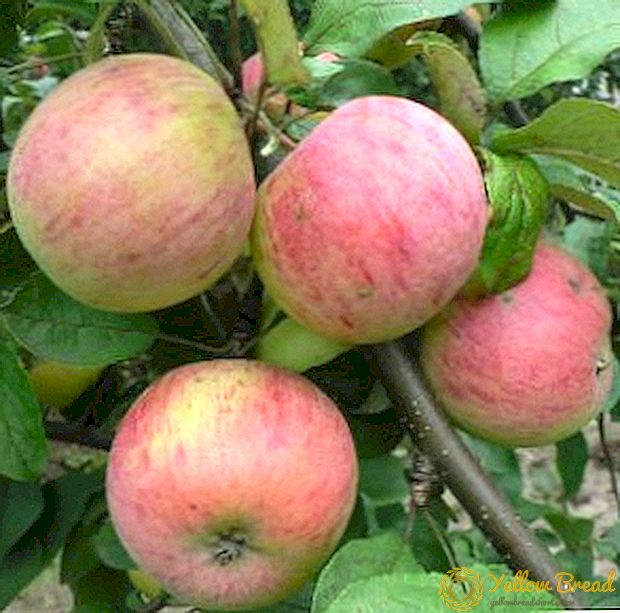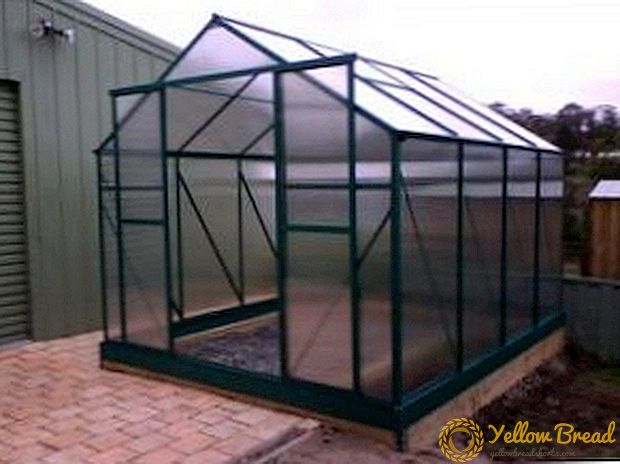
What is common in cucumber, tomato, mandarin and feijoa? The answer is that in order to be fruitful with maximum efficiency, they all need a warm, humid environment.
How often do you allow yourself to enjoy the juicy taste of any unusual tropical fruit?
There is a means by which, two steps from your own home, you will find grapefruit and lychee, orange and dragon fruit, tarragon and barberry.
And the remedy is greenhouse. The tool, the implementation of which is relatively budget and not too time consuming.
How to make a greenhouse with your own hands from the profile pipe
The construction of the greenhouse can be divided into several stages:
- The choice of the construction site.
- Foundation preparation.
- Mounting frame.
- Covering covering material.
- Sealing design.
Following the recommendations below will to simplify the process of installing the greenhouse with your own hands.
It is advisable to prepare in advance drawings of greenhouses from the profile pipe with dimensions.
Choice of construction site
First you need to choose a place where we will build our greenhouse. It should be smooth, without tall trees, if possible, close to the house (in the case of winter operation, it will be easier to carry out the heating by connecting to the heating source of the house).
Foundation preparation
The foundation on which we are going to build a greenhouse can be of 3 types:
- Beam It is carried out from a wooden bar with the carried-out external processing for prevention of corrosion. The service life of this type of foundation is up to 10 years.
- Brick. The use of this type of foundation becomes rational in cases where the installation of the greenhouse has to be done on the site with the presence of natural slope. Service life - up to 30 years. It is carried out by performing masonry width "in brick" on the fine solution, mixed in a ratio of 1: 3 (cement - sand).
- Concrete. This type of foundation is the most durable, however, its construction is associated with the greatest complexity. For its construction should dig a trench, the depth and width of one bayonet shovels. Then, either equip it with a frame welded from reinforcement - in this case, the life of the foundation becomes 50 years old, or just pour concrete (up to 60 years). Concrete should be kneaded in a ratio of 1: 4: 3.5 (cement, sand, small pebbles or broken stone).
The choice of the type of foundation should be carried out on the basis of considerations of durability, cost, and the conditions in which the construction is carried out.
Frame Mounting
 Installation of the frame for the greenhouse can be made of various elements of metal, but the most practical of them is a profile pipe.
Installation of the frame for the greenhouse can be made of various elements of metal, but the most practical of them is a profile pipe.
The profile pipe is a metal pipe with a rectangular cross section. Presently the profile pipe is one of the most widespread elements of metal rolling.
It is classified by the length of the sides. Most often used for the production of frame structures, due to such features:
- load is evenly distributed over the faces a rectangle, the shape of which has a cross section of the profile that provides increased strength of the finished frame;
- reasonable price per meter profile tube makes the use of this material the most advantageous for the installation of frame structures;
- rectangular sectional shape simplifies the skinning procedure honeycomb polycarbonate;
- the use of a profile pipe guarantees durability of the structure.
The best varieties of the profile pipe for mounting the greenhouse frame are considered to be profiles with sides of 40x20 and 20x20, the difference between which is to calculate the specific load per unit surface area.
Also, the choice of the profile used depends on the type of greenhouse from the profile pipe we are going to build. They are arched, lancet or pyramidal.
A photo
Look at the photo: drawing of the frame of the greenhouse from the profile pipe





Greenhouses from the profile pipe do it yourself
Arched
Greenhouses with a vault in the shape of a semicircle. Installation of this type of frame is associated with the need for uniform bending of the profile. This design is preferable for low-cost manufacturing of the greenhouse, contributes to the dispersion of sunlight and reduces the likelihood of snow accumulation during operation in winter.
For the installation of arch type greenhouses, it is necessary to use a 40x20 profile for support frames, 20x20 - for longitudinal bridges.
Bearing frames are made by bending a profile pipe. There is a question how to bend a profile pipe for a greenhouse. Bending can be done either manually or with a pipe bender.
Consider the option of manual manufacturing bearing frames.
A pair of plugs is cut out of wood or plastic, which plugs the end of the pipe. Inside sand is poured, rammed as the pipe is filled.This is done so that, when bent, the load on the inner surface is evenly distributed.
The middle of the profile is marked, then it is fixed on a concrete ring with a diameter of 3 m. The bending is performed simultaneously in both directions, at an angle of 90 degrees to the fixation point.
In addition, there is the option of bending the profile pipe using manual profile benders. The home-made machine, of course, will be inferior in the presentability of the factory, but it can perform its direct functions just as well.
To create a profiler at home with your own hands, you will need:
- Corner or channel from which the bed is welded, on which the machine design will be located.
- Legs from a pipe or metal profile.
- Bending shafts (you can order them from the turner or at the metal depot).
- Transmitting chain mechanism. If possible, you can use the transmission gears from the timing mechanism VAZ 21-06.
- Tensioner (from the same place).
- Shaft guide. It can be made by welding two 20 mm corners together.
- The driving element of the guide. It is made of a profile pipe 40x20 mm.
- Adjustable screw.
- Handle - from scrap material.
- Fasten the main shafts to the bolts, after making a slot for them in the channel.
Pointy
Greenhouse-shaped "house". Can be single or gable. Installation requires skills in welding.
Installation of greenhouses of this type is performed by fastening individual parts of the profile pipe with tacks, so that the lintels form windows 40x60 cm, 60x60 or 80x60, depending on the type of plating used (the narrower the heavier).
Use lancet type frame ensures direct sunlight entering the greenhouse, plus gives the opportunity to equip walls with reflectors. It is recommended for greenhouses in which it is planned to grow especially light-loving crops.
Pyramidal
The pyramidal frame of the greenhouse from the profile pipe is more rational for the construction of greenhouses, or buzfundamentalny folding, portable greenhouses. In fact, it is a “cap” that covers a certain part of the soil in order to form a microclimate under it.
Covering covering material
For covering the finished frame can be used such materials:
- polyethylene film;
- glass;
- sheets of polycarbonate.
The use of plastic film is the least durable version of the skin. It will have to change every year.
Glass - a pretty good option for plating. It provides an excellent level of light transmission, as well as the tightness of the structure, with proper processing of the joints. Among the negative characteristics of glass as a covering material for greenhouses - its weight and fragility.
Polycarbonate is a modern synthetic material, most rational for using it as a plating for a greenhouse. And drawings of greenhouses from a profile pipe can easily be found on the Internet.
This is due to such features:
- The combination of "strength-lightness" allows, if necessary, to do without the construction of capital foundations.
- Translucency.For this type of material, it is about 90% - this is more than enough for normal growth of greenhouse crops.
- Thermal insulation - polycarbonate honeycomb structure implies the formation of an air gap.
 Consider the process of covering the finished frame with sheets of polycarbonate:
Consider the process of covering the finished frame with sheets of polycarbonate:
- depending on the type of the mounted greenhouse it is laid out, then a sheet of polycarbonate is cut, for reasons of preserving the maximum holistic plane;
- on the places of contact of the sheet with the metal frame, we install rubber linings, we also stretch the place of the junction of the sheets - this will facilitate further sealing;
- the sheet is sewn to the frame with self-tapping screws, with the obligatory use of thermo washers. Holes for self-tapping screws are drilled in advance, 1-2 mm larger than their diameter - this will prevent the cracking of the sheet structure during thermal expansion;
- the trim should be calculated at the rate of 30 self-tapping screws on a six-meter polycarbonate sheet. It is not necessary to sew up each place of contact with the frame - polycarbonate does not like a large number of holes;
- polycarbonate sheet should be mounted honeycomb down - this is the probability of condensate accumulation in them;
- If you seal the holes in the combs with a special tape, you can prevent dirt and insects from accumulating in them.
Sealing design
Sheet joints should be treated with silicone or sealant, in order to make the structure tight, which is a prerequisite for the formation of a microclimate.
For the same purpose, the gap between the foundation and the plating sheets is processed with a mounting foam of finely porous structure.
As you can see, the greenhouse from the profile pipe 20 at home, with your own hands, is quite real. In addition, with the responsible implementation of the recommendations given above, it does not require large expenditures of labor and finances.
Of course, the choice of the type of material remains at the discretion of the master, but when using the materials specified in the recommendations, the ratio "price - quality" acquires the most acceptable parameter.
We hope you know the answer now. how to make a greenhouse from a shaped pipewhether it is necessary to order a greenhouse project from a profile pipe, what distinguishes a greenhouse from pipes and other metal greenhouses.

